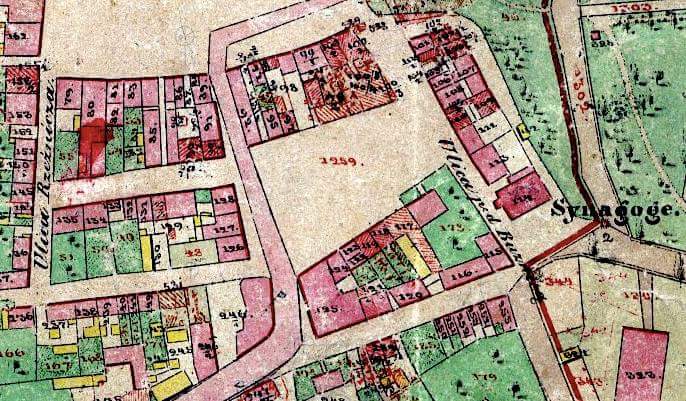
Alternate names: Łańcut [Pol], Lantzut, לאַנצוט [Yid], Lantsut [Ger]. 50°04' N, 22°14' E, 31 miles NW of Przemyśl, 10 miles E of Rzeszów. 1900 Jewish population: 1,940. Yizkor: Lancut; hayeha ve-hurbana shel kehila yehudit, (Tel Aviv, 1963). Łańcut is a town in SE Poland with 18,004 inhabitants in June 2008. Situated in the Subcarpathian Voivodeship since 1999, it is the capital of Łańcut powiat. synagogue photo. Jews first were documented in Lancut in 1554. Constraints on Jewish settlement in Lancut issued by city rulers and owners meant that the Jewish population steadily increased, but less dynamically than in other cities in the early years . Elimelech Lipman, son of Eleazar and later a famous tzaddik Leżajsk, lived in Lancut. Jacob Itzhak Horowitz, the Seer of Lublin, also worked here. Near the castle is the restored 18th century synagogue with its main hall and central bimah of four thick columns with richly carved capitals. The aron ha-kodesh, located on the east wall, has Cohan blessing hands made from colorfully painted stucco adorned with a crown and an ornament plant. The upper band of the stucco walls to the ceiling arch has rich patterns of plants and rocailles (stylized Rococo shells). The balance of the sanctuary is a riot of scenes, patterns, and symbols. The torah and its rimonim and pointer, menorah, seder plates, and lamps are on display. The synagogue can be visited by prior arrangement. This email address is being protected from spambots. You need JavaScript enabled to view it., fax. 017 225 20 12). [May 2009]
CEMETERY:
Lancut has two Jewish cemeteries. The older located on ulica Moniuszki contains individual gravestones or fragments. Two ohel were rebuilt thanks to Rabbi Mendel Reichberg. A larger one on the right is the tomb of Cwi Naftalego Horowica Ropczyce (d. 8 May 1827), one of the most famous tzaddiks in Galicia, famous pupil of Leżajsk Elimelech, Menachem Mendel of Israel and the Rymanow Kozienice. The second ohel is erected over the grave of Eleazar, son of Cwi Elimelech, founder of the Dynowskie dynasty j tzaddikim, (d. 3 September 1865). The keys to the gate and cemetery ohels are with Helena P. Kuźniar, ul. Jagiellonian 17 (found past ulica Jagiellońską 15 and 19 via the concrete walkway leading far into the garden). To make arrangements in advance, call (017 225 21 42). The cemetery is fenced and orderly. The second cemetery, probably from1860, is at the current ulica Traugutta. The cemetery was destroyed by the Germans with the help of some Lancut residents who stole gravestones for various purposes like a grinding wheel. After WWII, many matzevot remained in the cemetery. Some traces of border, matzevot, and destroyed graves are visible. A Holocaust memorial plaque is installed. Part of the matzevot are stored inside the synagogue. Photos of gravestones in the synagogue. [May 2009]
ShtetLink. [November 2002]
REFERENCE: They Lived Among Us: Polish Judaica, a travel brochure: Arline Sachs, This email address is being protected from spambots. You need JavaScript enabled to view it.
BOOK: Gruber, Ruth Ellen. Jewish Heritage Travel A Guide to East-Central Europe. New York: John Wiley & Sons, Inc., 1992. p. 53
LANCUT (I): US Commission No. POCE000496
Alternate name: Landsteut in German. Lancut (I), is located in Rzeszow at 50º0422º14, 20 km from Rzeszow. Cemetery location: Moniuszki St. Present town population is 1,000-5,000 with no Jews.
- Town: Urzad Miasta, ul. Swierczewskiego 9, 37-110 Lancut, tel.22202.
- Local: Wojewodzki Konserwator Zabytkow, 35 Rzeszow, ul. Mickiewicza 7.
The earliest known Jewish community was 1563. 1939 Jewish population was 2753. Living here was Rabbi N. Horowitz, who was buried there in 1831. Progressive/Reform Jews used this cemetery, 1 km from congregation. The isolated urban hillside has no sign or marker. Reached by turning directly off a public road, access is open to all with no wall or gate. The size of the cemetery before WWII was 790 sq. m. 1-20 limestone or sandstone flat shaped tombstones with Hebrew inscriptions date from 17th-19th century. No mass graves. The municipality owns site used as a Jewish cemetery only. Properties adjacent are residential. The cemetery boundaries are smaller than in 1939 due to a housing development. Frequently, organized Jewish groups and individual tours, private visitors, and local residents visit. The cemetery was vandalized during WWII and occasionally since. There is no maintenance or care. The cemetery has an ohel. Security, vegetation, and vandalism are very serious threats.
Natascha Rode, 35-213 Rzeszow, ul. Sterzynskiepo 5/29visited site and completed survey May 1992. Documentation used: from Wojewodzki Konserwator Zabytkow Rzeszow. No interviews.
LANCUT (II): US Commission No. POCE000497
See Lancut (I) for town information. Cemetery location: Traugutta St. The cemetery was established in 1860 with last burial in 1942. The cemetery was 1 km from the congregation that used it. The isolated urban flat land has no sign or marker. Reached by turning directly off a public road, access is open to all. There is a fence with a non-locking gate. Present size of the cemetery is 750-sq. m. 1-20 limestone and sandstone gravestones date from 19th-20th century. Some have iron decorations or lettering. There is a special memorial monument to Holocaust victims but no mass graves. The municipality owns site used for a Jewish cemetery only. Properties adjacent are recreational. Occasionally, private visitors and local residents visit. The cemetery was vandalized during WWII and occasionally since. Municipal authorities fixed wall and gate but now, there is no care. There are no structures. Vegetation and vandalism are moderate threats.
Natascha Rode completed the survey in May 1992. See Lancut (I) for details.
Map from a Facebook page:
[UPDATE] Photos by Charles Burns [March2016]

